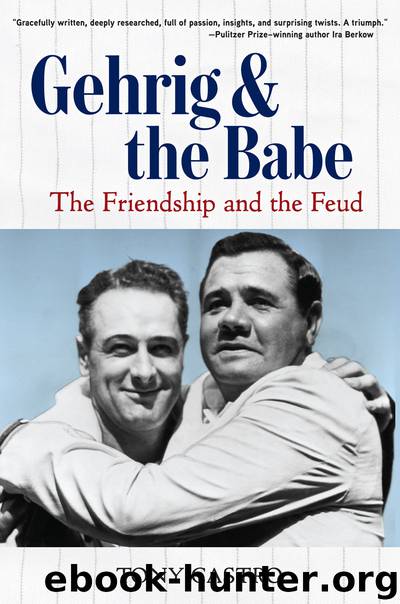Gehrig and the Babe by Tony Castro

Author:Tony Castro
Language: eng
Format: epub
Publisher: Triumph Books
Published: 2018-01-20T05:00:00+00:00
10. The Eastern Babe
“We won the Series in 1926, and I sometimes wonder if the only reason is that Gehrig didn’t get to bat in the ninth inning.”
—Rogers Hornsby, St. Louis Cardinals player/manager
In the years ahead, no player better understood Babe Ruth’s place in the game than Lou Gehrig, his fellow slugger, with whom he formed the marrow of their Murderers’ Row Yankee teams. Ruth, of course, was already his larger-than-life self as player and celebrity when Gehrig became a starter in 1925. So it was natural that Lou held back and often deferred to the Babe. “At first the two dissimilar men formed a mutual admiration society, despite the fact that Ruth was an outrageously undisciplined man in every facet of his life except home-run hitting, while the modest, insecure Gehrig was never much taken with flamboyance or empty boasting,” wrote biographer Ray Robinson, author of Iron Horse: Lou Gehrig in His Time. “Ruth and Gehrig should have grown closer with the passing years. Instead, they pulled apart, their sharp differences of personality and character souring their relationship.”
It did not start out that way. From afar, while a student and player at Columbia, Gehrig had looked up to Ruth—an admiration that had caused him to be awestruck in Babe’s presence when he met him at Yankee Stadium in 1923, which continued for the next few years. As far back as his early days at Commerce High School, Lou had relished the comparisons sometimes made of him to Ruth, who was then a member of the Boston Red Sox as both a pitcher and hitter. It had been Gehrig’s ninth-inning grand slam in a 1920 intercity game at Chicago’s Wrigley Field that led some sportswriters to liken him to Babe. And though his last name was misspelled in one newspaper account, Gehrig didn’t seem to mind. The feat brought him to the attention of the athletics department at Columbia, which encouraged him to enroll. It was the beginning of the nickname that, uncomfortable as it was for young Gehrig, would stick with him for a while: Columbia Lou. Later, a few sportswriters tried giving Lou the nickname “Buster,” But that didn’t stick either. Some had overheard Babe calling him that during his tryout in 1923, though Ruth had used it only because, as usual, he had forgotten Lou’s name as quickly as he had been introduced.
Gehrig, as a newly signed rookie, was hardly on anyone’s mind. After signing his contract, Lou spent the rest of 1923 playing for the Yankees’ farm team, the Hartford Senators of the Class A Eastern League. He was barely 20. But quickly made an impression with the team’s front office, which in 1924 promoted him to start the season with the Yankees. It was a decision they may have been too hasty in making. For all his promise, Gehrig was destined to spend much of the season riding the bench, being primarily employed as a pinch hitter. Veteran Wally Pipp, after all, was still the team’s starting first baseman.
Download
This site does not store any files on its server. We only index and link to content provided by other sites. Please contact the content providers to delete copyright contents if any and email us, we'll remove relevant links or contents immediately.
Kitchen confidential by Anthony Bourdain(2834)
Dry by Augusten Burroughs(1997)
I Know Why the Caged Bird Sings by Maya Angelou(1918)
Kitchen Confidential by Anthony Bourdain(1796)
A Child Called It by Dave Pelzer(1751)
KITCHEN CONFIDENTIAL Adventures in the Culinary Underbelly by Anthony Bourdain(1701)
A Heartbreaking Work of Staggering Genius by Dave Eggers(1679)
I know why the caged bird sings by Maya Angelou(1655)
Zeitoun by Dave Eggers(1519)
all by Unknown Author(1496)
Taken by J. C. Owens(1486)
Extraordinary, Ordinary People by Condoleezza Rice(1422)
Vogue on Yves Saint Laurent by Natasha Fraser-Cavassoni(1414)
A Stolen Life by Dugard Jaycee(1403)
The Farm in the Green Mountains by Alice Herdan-Zuckmayer(1361)
Law Man by Shon Hopwood(1352)
House of Darkness House of Light by Andrea Perron(1345)
The Big Sea by Langston Hughes(1282)
The Year of Yes by Maria Headley(1280)
